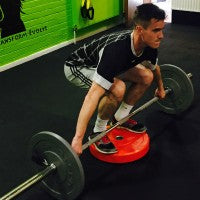In part one of this article we looked at conventional, hex bar, sumo, Romanian, and suitcase deadlifts. In part two we look at 6 more deadlift variations.
Snatch Deadlifts
 Snatch deadlifts are an advanced form of the deadlift. A wide hand grip is used so the body has to start in a deeper position, increasing the range of movement. This makes the exercise more difficult to perform than the other versions.
Snatch deadlifts are an advanced form of the deadlift. A wide hand grip is used so the body has to start in a deeper position, increasing the range of movement. This makes the exercise more difficult to perform than the other versions.
Increasing the range of motion not only makes the exercise harder but also increases the effectiveness of the exercise. The range of movement can be further increased by performing the deadlift on a low height platform.
Snatch deadlifts may also have the greater carry over to sports. The increase in the range of movement more effectively targets the posterior chain. Having a strong posterior chain is essential for optimal performance in many sports. Snatch deadlifts also increase the dynamic mobility and flexibility through the hips which may also be important for sport performance.
Snatch deadlifts would also be a good choice to target the glutes and quadriceps as you have to start in a deeper position and more stress is placed on these muscles.
 Deadlifts with Toes Raised
Deadlifts with Toes Raised
Most people are familiar with placing small weight plates under their heels when they squat to increase the workload on the quadriceps. However, placing weight plates under the toes when you deadlift will increase the workload on the hamstrings (especially in the stiff legged and Romanian variations).Partial Range Deadlifts
Partial range deadlifts, as the name suggests, are deadlifts performed through a limited range of movement. For example: deadlifts performed in a power rack with the pins set just above the knees to work the top half of the movement. Performing deadlifts this way can be useful if you’re weak in a specific range of the movement. In the example above, deadlifting from the pins set just above the knee would target the erector spinal. This would help you increase strength in the top range of the movement, overcoming weaknesses in locking out the deadlift. Deadlifting through a partial range may also be helpful for anyone returning from an injury until the load can be lifted through the entire range of the lift.
 Grip Variations
Grip Variations
Power and strength athletes will use an alternate grip—one hand is facing you (pronated) and the other facing away from you (supinated)—when they deadlift as it is considered a better grip to lift heavier weights. Remember! Alternate which hand is pronated and supinated on each set to develop strength evenly throughout the body. As straps are  more frequently allowed in competitions nowadays, this grip is seen less often but is still a useful alternative to help develop grip strength.
more frequently allowed in competitions nowadays, this grip is seen less often but is still a useful alternative to help develop grip strength.
Dumbbell and Kettlebell Deadlifts
Deadlifting with dumbbells allow for a more natural and longer range of movement, increasing muscle fiber activation. Deadlifting with kettlebells changes the strength pattern of the movement as the load of a kettlebell is below the center of your grip. In other words, the weight is below the handle, not in line as it is with dumbbells and barbells. This provides a new stimulus for the body to adapt to.
 Deadlift with Chains
Deadlift with Chains
The deadlift can be performed with chains attached to the ends of the bar. Chains change the strength curve of the movement. Attaching chains will challenge you to produce a greater force in the end range of the movement (as the bar becomes heavier the more the bar is lifted from the floor), overloading in the end. Deadlifting with chains may help you overcome a weakness in locking out the deadlift.Conclusion
These are just some of the many variations of the deadlift. Hopefully you have a good idea now of some of the benefits these deadlift variations have to offer and how to use this information to help benefit you in your training.
I would like to thank Ricky Light and James Waggitt from www.effectusfit.co.uk for helping me with the demonstrations and letting me use their awesome studio.





